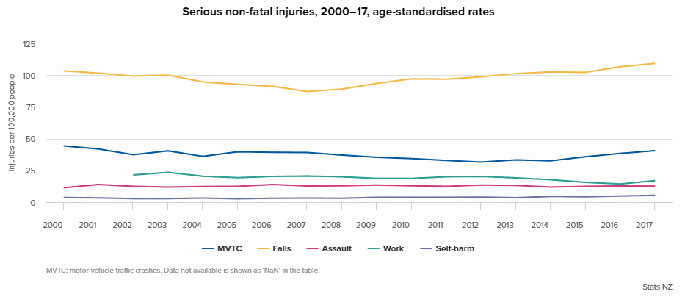The rates of serious non-fatal injuries from falls and from self-harm were at record highs in 2017, Stats NZ says today.
The rate for motor-vehicle crashes was also the highest for 16 years.
At 109.2 injuries per 100,000 people, the age-standardised rate for serious non-fatal injuries from falls was the highest on record in 2017 provisional data.
Serious non-fatal intentional self-harm injuries were also at their highest recorded rate in 2017, at 5.3 injuries per 100,000 people. Similarly, injuries from motor vehicle crashes reached their highest rate since 2002, at 40.5 injuries per 100,000 people.
Together, these contributed to the overall rate of serious non-fatal injuries in 2017 being the highest on record.

'Serious non-fatal injuries are those that can be life threatening. Information about these injuries provides insight into injury risks for New Zealanders, and a broader view than just looking at fatalities,” says government injury information manager James Clarke.
Serious non-fatal injuries are injury events in which a patient admitted to hospital is determined to have a probability of death of 6.9 per cent or more.
On average, they make up around 82 per cent of all serious (fatal and non-fatal) injuries.
'Although serious non-fatal injuries have increased recently, it's unclear if fatal injuries will also show the same trend. The increase in non-fatal injuries could also be due to more people surviving serious injury events, in which case we may see fatalities decline."
Validated data on fatal injuries is only available up to 2015, to allow for the coroner's verification process. However, alternative provisional data series indicate an increase in fatal motor-vehicle crashes and suicides from 2015 to 2017.
Data on fatal injuries up to 2016 will be available in the next release in October 2019.



0 comments
Leave a Comment
You must be logged in to make a comment.